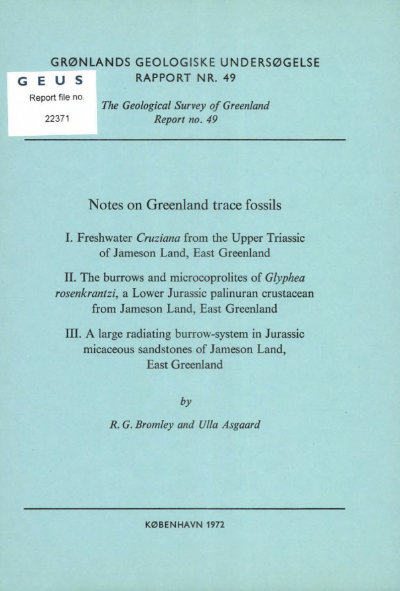Notes on Greenland trace fossils
DOI:
https://doi.org/10.34194/rapggu.v49.7317Abstract
Freshwater Cruziana from the Upper Triassic of Jameson Land, East Greenland.
An occurrence of well-preserved Cruziana problematica (Schindewolf) in Triassic red-beds in Jameson Land allows a more detailed morphological description of these trace fossils than has hitherto been possible. Rheotactic orientation of the traces indicates the direction of palaeocurrents in the area. C. problematica has previously been ascribed to branchiopod crustaceans, but the present material allows a narrowing of the field to Notostraca, and is supported by field observations of the living notostracan Lepidurus arcticus (Pallas).
The burrows and microcoprolites of Glyphea rosenkrantzi, a Lower Jurassic palinuran crustacean from Jameson Land, East Greenland.
In Toarcian sediments in Jameson Land, phosphatic concretions at certain horizons contain well preserved Glyphea rosenkrantzi. These crustaceans are confined to the fill of Thalassinoides burrow systems and it is therefore probable that the burrows were constructed by Glyphea. It is possibIe that associated microcoprolites of rod-like shape, without internal canals, may also be ascribed to the Glyphea.
A large radiating burrow-system in Jurassic micaceous sandstones of Jameson Land, East Greenland.
Large trace fossils consisting of more or less straight burrows radiating from a verticaI shaft are described from Jurassic sandstones of Jameson Land. The mica orientation of the sediment reveals the internal construction of the burrows and aids the interpretation of their mode of formation. The trace fossil has not been previously named and is designated Phoebichnus trochoides ichnogen. et ichnosp. nov.
Downloads
Published
Issue
Section
License
This article is distributed under a CC-BY 4.0 licence, permitting free redistribution and reproduction for any purpose, even commercial, provided proper citation of the original work. Author(s) retain copyright over the article contents.


